Uncover the mysteries of the Sheep Gate, an ancient biblical entrance with deep spiritual significance, waiting to reveal its stories.
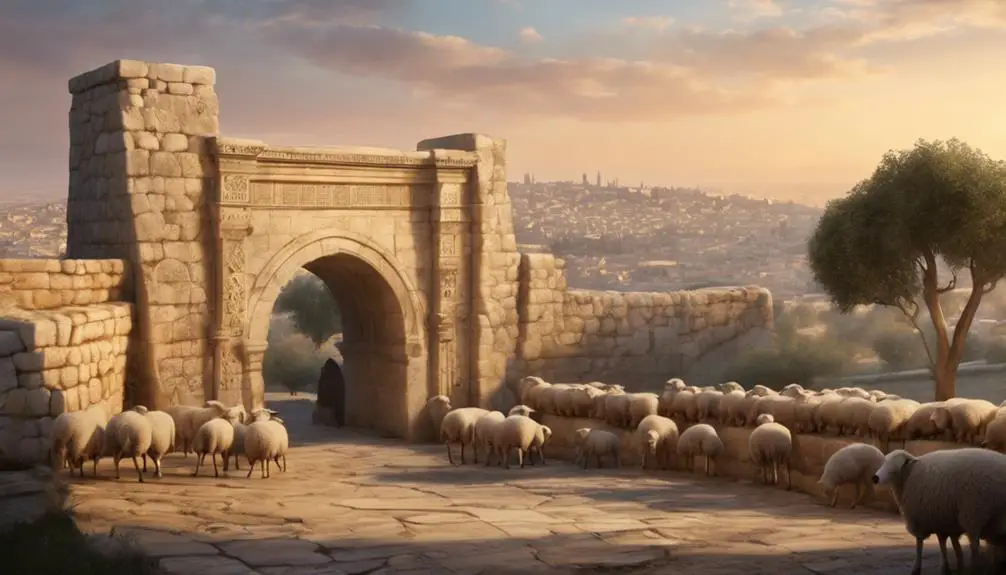
What Is the Sheep Gate in the Bible
When you walk through the city of Jerusalem today, you might not immediately recognize the remnants of the Sheep Gate, an ancient biblical landmark steeped in history.
Situated near the Temple Mount, this gate served as a crucial entry for sheep destined for temple sacrifices. It's mentioned in the Bible, specifically in the book of Nehemiah, highlighting its significance not only in terms of physical structure but also in its spiritual connotation.
As we uncover the layers of its historical context, location, and the mysteries it holds, you'll find there's a deeper narrative waiting to be explored, one that connects the past with the present in unexpected ways.
Key Takeaways
- The Sheep Gate was a crucial entry point for livestock, symbolizing trade, sacrifice, and defense in ancient Jerusalem.
- It is mentioned in biblical passages, highlighting its spiritual significance in purification and redemption narratives.
- Located near the Pool of Bethesda, its structure and location underscored its importance in urban life and religious practices.
- Recent archaeological findings provide insight into its historical and economic role, enhancing our understanding of its spiritual symbolism.
Historical Context
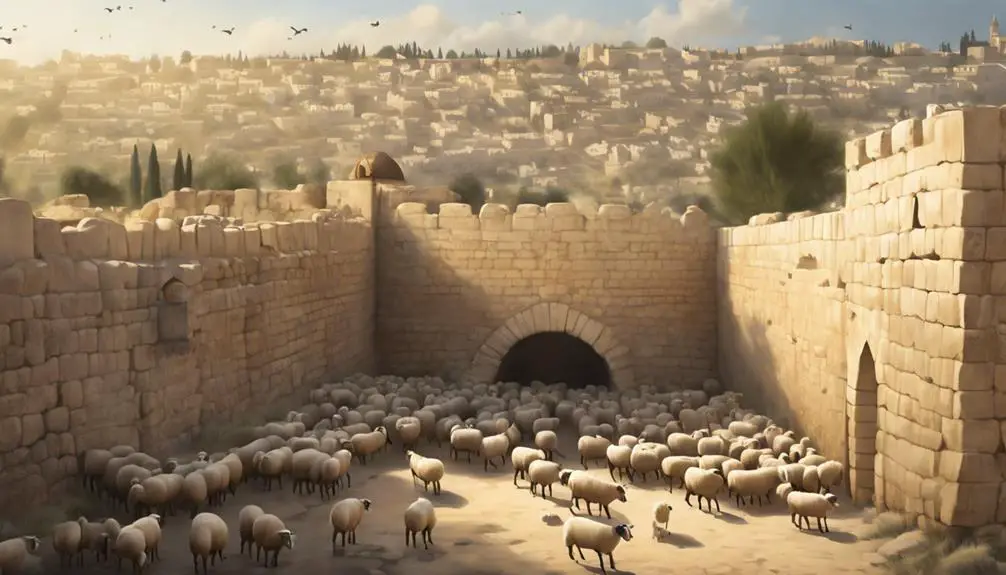
The Sheep Gate, a pivotal structure within Jerusalem's walls, holds significant historical relevance as it served both as an essential entry point for livestock and as a symbolic testament to the city's complex socio-economic fabric. You'll find that its role in animal trade was indispensable, facilitating the movement of sheep and other livestock into the city for both sacrificial purposes and general commerce. This gate wasn't merely a passageway; it was the lifeblood of Jerusalem's bustling market economy, ensuring a steady flow of animals necessary for religious rites and daily sustenance.
Moreover, the Sheep Gate's contribution to city defense was equally critical. In a time when city walls delineated the boundary between civilization and wilderness, every gate served as a potential vulnerability and a point of strength. You'd notice that the Sheep Gate, strategically positioned, allowed for the efficient management of goods while maintaining the city's security against potential invaders. Its very existence underscores a delicate balance between openness and fortification, symbolizing Jerusalem's resilience and adaptability throughout history.
In essence, the Sheep Gate was more than a mere aperture in Jerusalem's walls; it was a cornerstone of the city's animal trade and defense strategy, reflecting the intricacies of urban life in ancient times.
Location and Structure
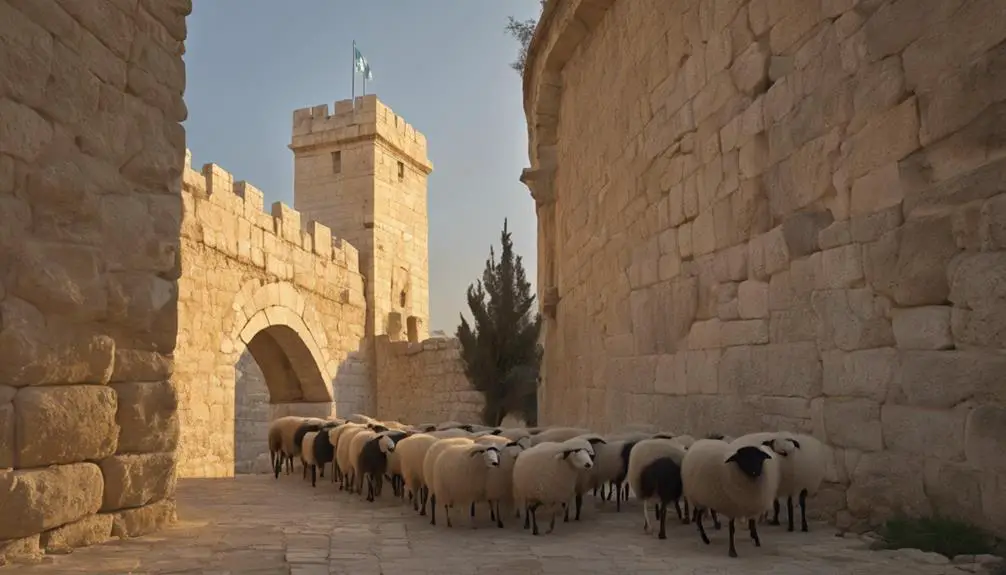
Having explored the Sheep Gate's pivotal role in Jerusalem's socio-economic and defensive frameworks, we'll now examine its geographical positioning and architectural characteristics. Situated in the northeastern wall of Jerusalem, the Sheep Gate served as a critical entry point, particularly for those involved in the temple's sacrificial practices. Its proximity to the Pool of Bethesda underscored its significance for both ritual purification and commerce.
In terms of structure, the Sheep Gate was notable for its robust construction, designed to withstand the rigors of both time and military engagement. The gate's dimensions were substantial, ensuring it could accommodate the flow of livestock and people. Construction materials primarily comprised large, carefully quarried stones, hinting at the gate's importance and the investment in its durability.
To evoke the depth of its historical and architectural significance, consider the following:
- *The sheer size of its stones, each bearing silent witness to centuries of passage.*
- *The meticulous craftsmanship, indicative of a society valuing both form and function in its sacred and communal spaces.*
- *The resilience of the structure, standing as a testament to the enduring nature of faith and community in ancient Jerusalem.*
Analyzing the Sheep Gate's location and structure reveals its multifaceted role in the city's life, blending practical necessity with profound spiritual symbolism.
Biblical References
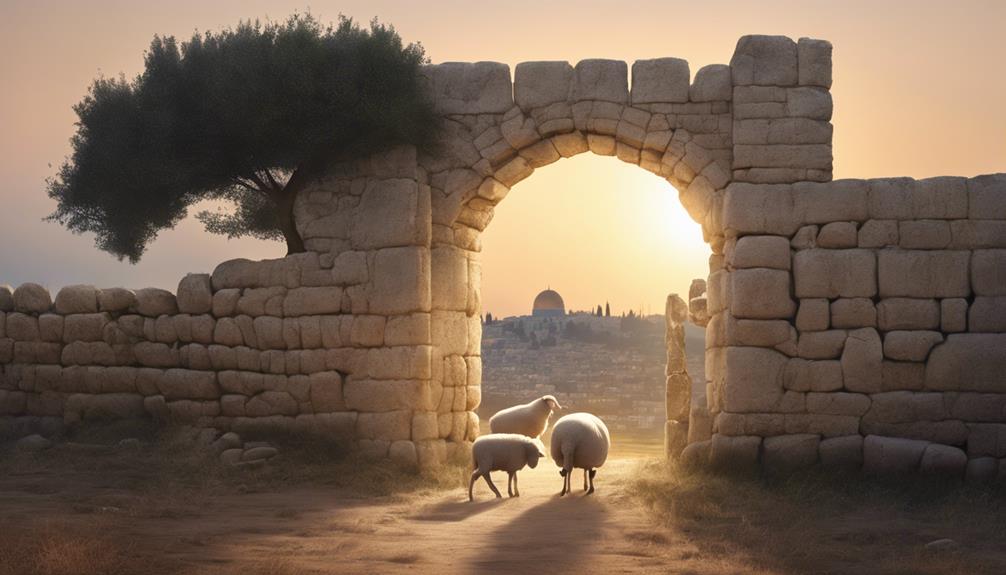
In examining biblical references, one finds that the Sheep Gate holds a significant place in scriptural narratives, serving as a backdrop to pivotal religious events and teachings. Its significance is not merely architectural but extends into the pastoral and agricultural practices of the time, including the care and breeding of sheep.
Passage |
Description |
|---|---|
Nehemiah 3:1 |
The Sheep Gate's repair is detailed, reflecting its physical structure and the community's dedication to restoration. |
Nehemiah 12:39 |
This passage underscores the gate's role in ceremonial processions, linking it to religious practices. |
John 5:2 |
The mention of the Sheep Gate near the pool of Bethesda introduces its proximity to places of healing and miracles. |
Genesis 29:2-3 |
While not directly mentioning the Sheep Gate, this passage provides context on ancient water sources for sheep, hinting at the gate's practical purpose in herding. |
| 1 Samuel 17:34-35 | David's reference to protecting his sheep from predators highlights the protective aspect of gates, possibly including the Sheep Gate.
These references, when analyzed, reveal a complex interplay between the physical gate designs and the shepherd's knowledge of sheep breeds. The biblical narrative weaves together the functional, the spiritual, and the communal, offering a rich tapestry of meanings behind the Sheep Gate's mention in scripture.
Spiritual Significance
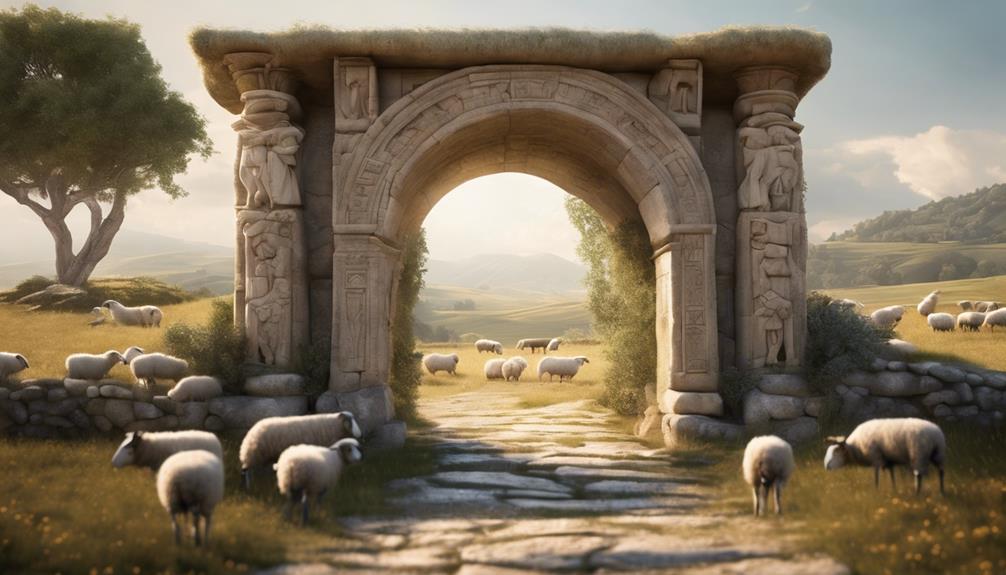
Exploring beyond the physical and communal aspects of the Sheep Gate, we uncover its deep spiritual significance within biblical narratives, offering insights into the religious practices and beliefs of the time. This gate, more than just an entryway for livestock, symbolizes pathways to purity and redemption in the religious context of ancient Jerusalem. The Shepherd symbolism and Sacrificial metaphor inherent in the Sheep Gate's narrative intertwine, presenting a rich tapestry of spiritual meaning.
- Shepherd Symbolism: It reflects the leadership and care of divine guidance, evoking the image of a shepherd leading his flock to safety. This imagery resonates deeply with the concept of spiritual guidance and protection.
- Sacrificial Metaphor: The gate's association with the path taken by animals destined for temple sacrifices underscores themes of atonement and redemption. It serves as a poignant reminder of the sacrificial system central to ancient religious practice.
- Pathway to Redemption: The Sheep Gate's role in religious rites emphasizes the journey of the faithful towards spiritual purification and salvation.
Through this lens, the Sheep Gate stands as a profound metaphor for spiritual journey and sacrifice, enriching our understanding of its place in biblical and religious history.
Archaeological Discoveries
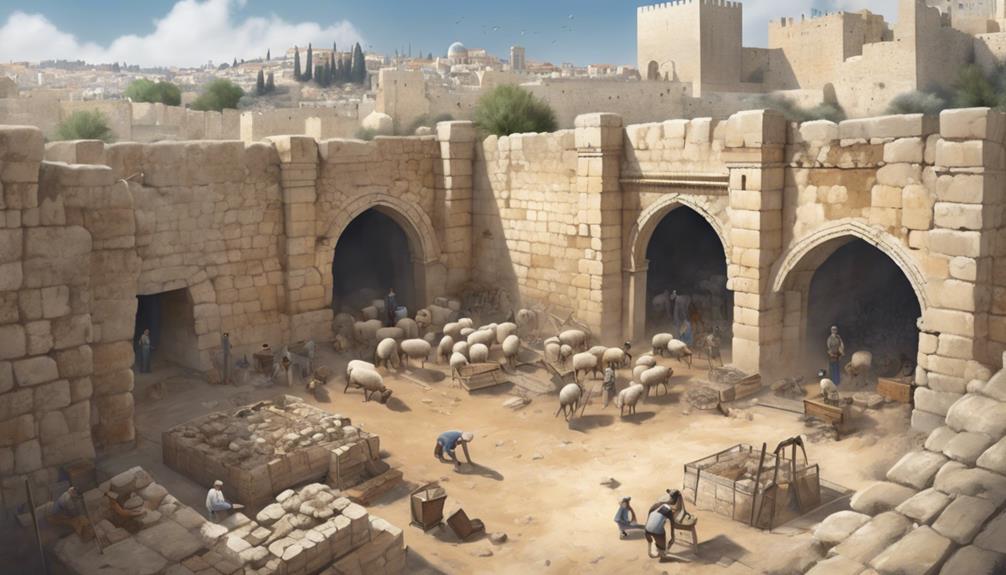
Recent archaeological excavations have unearthed significant findings related to the Sheep Gate, shedding light on its historical and spiritual dimensions. These discoveries haven't only provided tangible evidence of the gate's existence but have also offered insights into the management and conservation of sheep breeds in ancient times. Analysis of animal remains found near the site reveals a diversity of sheep breeds, suggesting a sophisticated understanding of breeding practices aimed at improving wool quality and meat yield.
Moreover, the evidence points to early conservation efforts, indicating a deliberate strategy to sustain and protect the sheep population. This aspect underscores the economic and cultural importance of sheep in the society, further emphasizing the Sheep Gate's role in the daily life and religious practices of the community.
The findings also include artifacts that illustrate the trade networks established for the exchange of sheep and wool, highlighting the gate's significance in ancient commerce. Such discoveries have allowed scholars to reconstruct the social and economic fabric of the time, offering a more nuanced understanding of the Sheep Gate's function and its contribution to the community's wellbeing.
Frequently Asked Questions
How Have Different Christian Denominations Interpreted the Symbolism of the Sheep Gate Throughout History?
You're delving into how Christian denominations have historically interpreted the symbolism of the Sheep Gate, focusing on pastoral metaphors and the gate's construction. This exploration uncovers a rich tapestry of beliefs, where the gate's physical structure often mirrors spiritual passages.
Scholars argue that these interpretations reflect broader theological views, with the gate serving as a metaphor for guidance and protection. Each denomination brings a unique lens, deeply analyzing the gate's role in spiritual journeying.
Are There Any Notable Artworks or Literary Works That Feature the Sheep Gate as a Central Theme or Symbol?
You're exploring the artistic influences and literary symbolism of the Sheep Gate, a theme woven into various artworks and narratives.
This inquiry delves into how creators have embedded this motif, signifying passages, transitions, or spiritual journeys.
Examining these representations requires a scholarly approach, dissecting how each piece interprets or reimagines the concept, thereby enriching our understanding of its multifaceted symbolism and its impact on cultural and religious narratives throughout history.
How Does the Concept of the Sheep Gate Relate to Modern Christian Practices and Ceremonies?
In exploring the concept of the Sheep Gate, you'll find its relevance to modern Christian practices through symbolism in sheep farming and gate design.
The gate represents access and protection, akin to pastoral care in churches. Similarly, sheep farming exemplifies guidance and care, reflecting the shepherd's role in Christianity.
Analyzing these elements provides a detailed understanding of how ancient biblical imagery continues to inspire and shape contemporary Christian ceremonies and spiritual guidance.
Have There Been Any Significant Political Events or Conflicts Centered Around the Actual Location of the Sheep Gate?
You're wondering if the Sheep Gate's location has been a hotspot for political events or conflicts. Interestingly, while urban development in the area might suggest potential for disputes, there haven't been significant political conflicts directly tied to it.
However, archaeological finds near the gate have sparked scholarly interest, contributing to our understanding of historical and cultural dynamics. These discoveries, rather than conflicts, highlight the gate's significance in weaving the historical narrative of the region.
How Do Jewish Interpretations of the Sheep Gate Differ From Christian Perspectives, Especially in Contemporary Religious Teachings?
You'll find that Jewish interpretations of the Sheep Gate largely emphasize its role in Temple rituals and its architectural significance, reflecting its historical and religious importance.
In contrast, Christians often view it symbolically, connecting it to Jesus' sacrifice. Both perspectives are deeply rooted in their respective traditions, offering a rich tapestry of understanding that diverges significantly, especially in contemporary teachings, highlighting the gate's multifaceted significance across different faiths.
Conclusion
In conclusion, you've explored the Sheep Gate's multifaceted identity, spanning its historical backdrop, architectural blueprint, scriptural mentions, and spiritual symbolism.
This gate, more than a mere point of entry, embodies a rich narrative interwoven with ancient rites, societal functions, and theological metaphors.
Recent archaeological findings further underscore its tangible presence in history, offering a concrete connection to the biblical narrative.
Through scholarly analysis, you've gained a nuanced understanding of the Sheep Gate's integral role in Judeo-Christian traditions, highlighting its enduring legacy.



Sign up